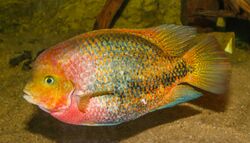Biology:Vieja melanurus
| Vieja melanurus | |
|---|---|

| |
| Scientific classification | |
| Domain: | Eukaryota |
| Kingdom: | Animalia |
| Phylum: | Chordata |
| Class: | Actinopterygii |
| Order: | Cichliformes |
| Family: | Cichlidae |
| Genus: | Vieja |
| Species: | V. melanurus
|
| Binomial name | |
| Vieja melanurus (Günther, 1862)
| |
| Synonyms | |
| |
Vieja melanurus, the quetzal cichlid, redhead cichlid or firehead cichlid, is a species of cichlid that is native to the Lake Petén system, the Grijalva–Usumacinta River basin and other Atlantic river drainages in southern Mexico, Belize and Guatemala, with introduced populations in a few other countries.[1][2][3] It typically inhabits slow-moving or standing waters such as rivers, lakes and lagoons; although primarily a freshwater fish, it may occur in slightly brackish habitats.[2][4][5] It is popular in the aquarium trade, where often listed under the synonym V. synspila/synspilum.[2][5] It is almost entirely herbivorous, but may also take small animal prey.[2]
V. melanurus can reach a total length of 35 cm (14 in).[4] Males grow larger than females and also develop a prominent nuchal hump on their forehead. Adults are quite colourful cichlids with an orange to pinkish-red head, a body often displaying greenish, bluish, pink and golden-orange, and a horizontal black bar (often patchy or mottled) at the base of the tail; the belly and mottling elsewhere on the body can also be black. There are significant individual and geographical variations in the colours; partially, this is related to the clarity of the water at a location.[2] Adults are always robust and high-bodied cichlids, but there are some regional variations depending on habitat.[6]
It has been used in creating new hybridized aquarium cichlids that became popular in Asia in recent years and is likely one of the species used in the creation of modern blood parrot cichlids and flowerhorn cichlids.
References
- ↑ Mcmahan, C.D.; Murray, C.M.; Geheber, A.D.; Boeckman, C.D.; Piller, K.R. (2011). "Paraneetroplus synspilus is a Junior Synonym of Paraneetroplus melanurus (Teleostei: Cichlidae)". Zootaxa 2833: 1–14. doi:10.11646/ZOOTAXA.2833.1.1.
- ↑ 2.0 2.1 2.2 2.3 2.4 Artigas Azas, Juan Miguel (9 May 2011). "Vieja melanurus (Günther, 1862)". CichlidRoom. https://cichlidae.com/species.php?id=235. Retrieved 28 December 2021.
- ↑ Eschmeyer, William N.; Fricke, Ron; van der Laan, Richard, eds. "Vieja melanurus". California Academy of Sciences. http://researcharchive.calacademy.org/research/ichthyology/catalog/fishcatget.asp?tbl=species&genus=Heros&species=melanurus.
- ↑ 4.0 4.1 Froese, Rainer; Pauly, Daniel, eds (2019). "Vieja melanura". http://www.fishbase.org/summary/SpeciesSummary.php?genusname=Vieja&speciesname=melanura.
- ↑ 5.0 5.1 "Vieja synspila". SeriouslyFish. https://www.seriouslyfish.com/species/vieja-synspila/. Retrieved 28 December 2021.
- ↑ McMahan, C.D.; Kutz, J.; Murray, C.M.; Chakrabarty, P.; Geheber, A.D.; Elías, D. (2017). "Objectively measuring subjectively described traits: geographic variation in body shape and caudal coloration pattern within Vieja melanura (Teleostei: Cichlidae)". Revista de Biología Tropical 65 (2): 623–631. doi:10.15517/rbt.v65i2.25500.
Wikidata ☰ Q3235135 entry
 |

